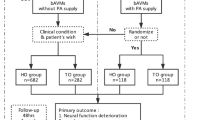Abstract
Objective
Combined surgical and endovascular treatment for vascular disorders has become prevalent in recent years. However, reports on one-session hybrid surgery for arteriovenous malformations (AVMs) are relatively rare. The safety and efficiency of combined treatment for brain AVMs were analyzed in biplanar hybrid operating room (OR) at one stage.
Methods
We retrospectively analyzed 20 patients with AVMs undergoing combined surgical and endovascular treatment from October 2015 to June 2018. The data for resection rate, microcatheter adhesion, surgical position and postoperative outcomes were analyzed. Total resection or near-total resection was achieved in all cases.
Results
A total of 13 patients were under combined endovascular and surgical procedures, and 7 experienced surgery with intraoperative digital subtraction angiography. Sitting position was applied in 3 of them; 2 niduses in cerebellum, and 1 in parietal lobe. Compared with admission modified Rankin Scale (mRS) in all patients, postoperative 12-month mRS showed a significant decline. Besides, 3 patients experienced microcatheter adhesion after endovascular embolization, thereafter underwent surgical adhesion removal while nidus resection was done.
Conclusion
Combined endovascular and surgical modality in a hybrid OR at one stage provides a safe strategy for the treatment of AVMs. The biplanar hybrid neurointerventional suite is endowed with unconstrained operating angle which enables combined endovascular and surgical treatment in sitting position. It also reduces the risk of microcatheter adhesion, which enables interventional radiologists to perform aggressively.
Similar content being viewed by others
References
Murayama Y, Arakawa H, Ishibashi T, et al. Combined surgical and endovascular treatment of complex cerebrovascular diseases in the hybrid operating room. J Neurointerv Surg, 2013,5(5):489–493
Xin C, Li Z, Zhang J, et al. Combined Surgical and Endovascular Treatment of a Complex Posterior Communicating Artery Aneurysm at One-Stage in a Hybrid Operating Room. World Neurosurg, 2018,116: 383–386
Chalouhi N, Theofanis T, Jabbour P, et al. Safety and efficacy of intraoperative angiography in craniotomies for cerebral aneurysms and arteriovenous malformations: a review of 1093 consecutive cases. Neurosurgery, 2012,71(6):1162–1169
Murayama Y, Saguchi T, Ishibashi T, et al. Endovascular operating suite: future directions for treating neurovascular disease. J Neurosurg, 2006,104(6):925–930
Murayama Y, Irie K, Saguchi T, et al. Robotic digital subtraction angiography systems within the hybrid operating room. Neurosurgery, 2011,68(5):1427–1432
Kretzer RM, Coon AL, Tamargo RJ, et al. Dandy’s contributions to vascular neurosurgery. J Neurosurg, 2010,112(6):1182–1191
Solomon RA, Connolly ES Jr. Arteriovenous Malformations of the Brain. N Engl J Med, 2017,376(19):1859–1866
Derdeyn CP, Zipfel GJ, Albuquerque FC, et al. Management of Brain Arteriovenous Malformations: A Scientific Statement for Healthcare Professionals From the American Heart Association/American Stroke Association. Stroke, 2017,48(8):e200–e224
Yu SC, Chan MS, Lam JM, et al. Complete obliteration of intracranial arteriovenous malformation with endovascular cyanoacrylate embolization: initial success and rate of permanent cure. AJNR Am J Neuroradiol, 2004,25(7):1139–1143
Bauer AM, Bain MD, Rasmussen PA. Onyx resorbtion with AVM recanalization after complete AVM obliteration. Interv Neuroradiol, 2015,21(3):351–356
Feutren T, Huertas A, Salleron J, et al. Modern robotassisted radiosurgery of cerebral angiomas-own experiences, system comparisons, and comprehensive literature overview. Neurosurg Rev, 2018,41(3):787–797
Abla AA, Rutledge WC, Seymour ZA, et al. A treatment paradigm for high-grade brain arteriovenous malformations: volume-staged radiosurgical downgrading followed by microsurgical resection. J Neurosurg, 2015,122(2):419–432
Mounayer C, Hammami N, Piotin M, et al. Nidal embolization of brain arteriovenous malformations using Onyx in 94 patients. AJNR Am J Neuroradiol, 2007,28(3):518–523
Hauck EF, Welch BG, White JA, et al. Preoperative embolization of cerebral arteriovenous malformations with onyx. AJNR Am J Neuroradiol, 2009,30(3):492–495
Weber W, Kis B, Siekmann R, et al. Preoperative embolization of intracranial arteriovenous malformations with Onyx. Neurosurgery, 2007,61(2):244–252
van Rooij WJ, Sluzewski M, Beute GN. Brain AVM embolization with Onyx. AJNR Am J Neuroradiol, 2007,28(1):172–177
Dehdashti AR, Thines L, Da Costa LB, et al. Intraoperative biplanar rotational angiography during neurovascular surgery. J Neurosurg, 2009,111(1):188–192
Nossek E, Chalif DJ, Buciuc R, et al. Intraoperative Angiography for Arteriovenous Malformation Resection in the Prone and Lateral Positions, Using Upper Extremity Arterial Access. Oper Neurosurg, 2017,13(3):352–360
Hashimoto H, lida J, Hironaka Y, et al. Surgical management of cerebral arteriovenous malformations with intraoperative digital subtraction angiography. J Clin Neurosci, 2000,7(Suppl 1):33–35
Yanaka K, Matsumaru Y, Okazaki M, et al. Intraoperative angiography in the surgical treatment of cerebral arteriovenous malformations and fistulas. Acta Neurochir, 2003,145(5):377–382
Author information
Authors and Affiliations
Corresponding author
Ethics declarations
The authors have indicated that they have no potential conflicts of interest to disclose.
Additional information
This work was supported by grants from the National Natural Science Foundation of China (No. 81771280) and the Technological Innovation Foundation of Hubei Province (No. 2018ACA139).
Rights and permissions
About this article
Cite this article
Xin, C., Luo, Wt., Zhao, Wy. et al. Combined Endovascular and Surgical Treatment for Brain Arteriovenous Malformations in Biplanar Hybrid Operating Room. CURR MED SCI 41, 782–787 (2021). https://doi.org/10.1007/s11596-021-2398-y
Received:
Accepted:
Published:
Issue Date:
DOI: https://doi.org/10.1007/s11596-021-2398-y




